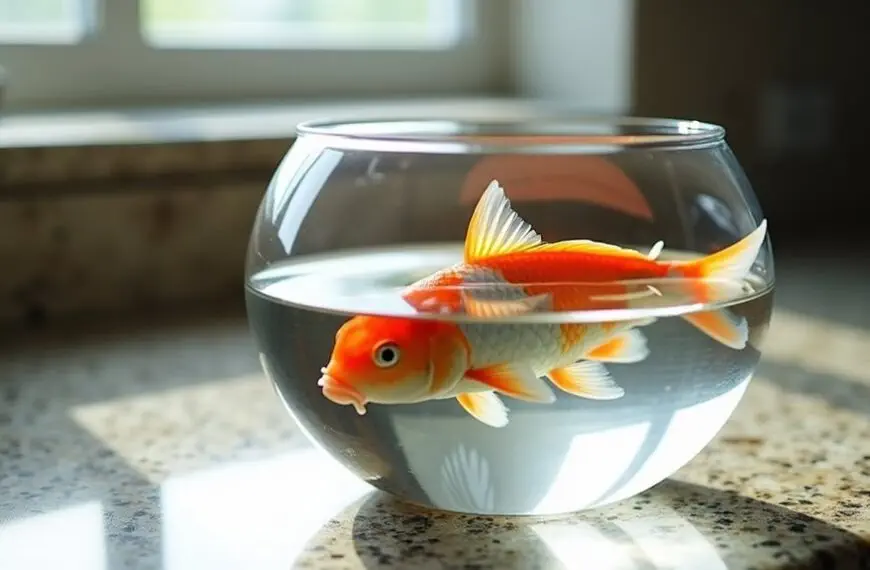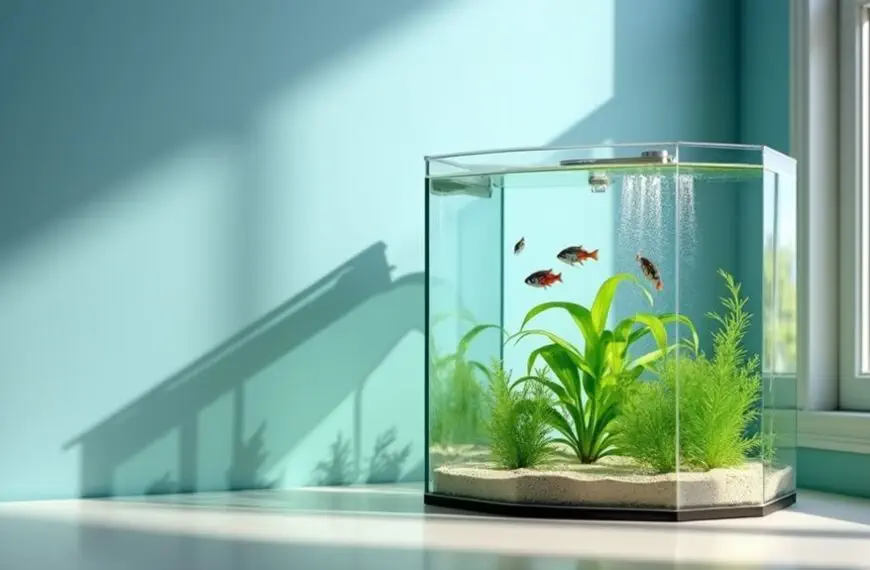Shore fishing with a simple spinning rod and reel combo is your best bet as a beginner. You'll want to target easy-to-catch fish like bluegill, panfish, and rainbow trout in local lakes or ponds, especially near weed beds and boulders. Start with a light to medium-light rod around 6-7 feet long, paired with basic tackle and live bait like worms. This setup typically costs about $300 and gives you the versatility to catch most freshwater species while learning proper casting techniques. The more you understand these fishing fundamentals, the better equipped you'll be to land that trophy catch.
Contents
- 1 Understanding Basic Fishing Equipment
- 2 Start With Spincast Reels
- 3 Choosing Your First Rod
- 4 Best Fish For Beginners
- 5 Essential Bait and Lures
- 6 Where To Fish
- 7 Basic Casting Techniques
- 8 Safety On The Water
- 9 Required Fishing Permits
- 10 Common Beginner Mistakes
- 11 Frequently Asked Questions
- 12 Final Thoughts
Understanding Basic Fishing Equipment
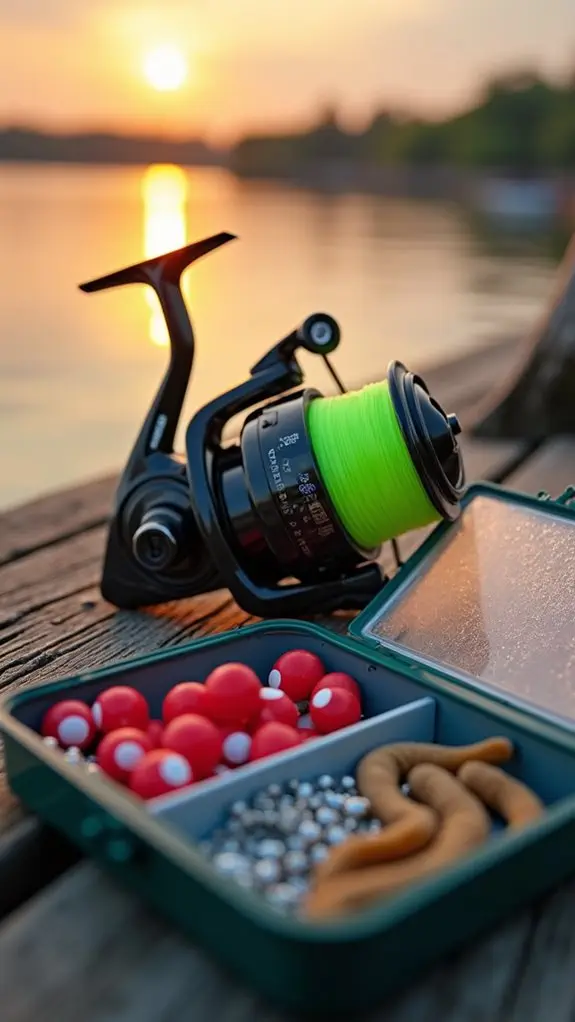
For anyone starting their fishing journey, understanding basic equipment is the cornerstone of success. You'll want to begin with a spinning rod and reel combo, which is perfect for beginners because it's user-friendly and versatile. The light to medium light setup is ideal for catching most freshwater fish species.
When you're selecting fishing tackle, don't let yourself get overwhelmed – start with the basics like hooks, simple baits, and a mid-sized tackle box to keep everything organized. Premium gear isn't always necessary, as quality gear typically costs around $300 for a complete starter setup.
Your best bet is a 6 or 7-foot medium action rod, and here's a tip: proper rod maintenance will help it last for years to come. While you might be tempted to buy the fanciest gear out there, stick with a reliable fiberglass rod that won't break the bank.
For your fishing line, monofilament is your friend – it's forgiving and perfect for learning the ropes.
Don't forget those essential hand tools! A pair of needle nose pliers and a line-cutter will save you from countless frustrating moments (trust me, we've all been there trying to untangle hooks with our fingers).
Remember to grab some basic lures, sinkers, and bobbers – they'll be your new best friends on the water.
Start With Spincast Reels
A spincast reel is your perfect entry point into the world of fishing. One of the biggest spincast advantages you'll notice right away is its user-friendly design, featuring a closed face that helps prevent those frustrating line tangles that often plague new anglers. You'll love how simple it's to cast – just press a button and you're ready to go! The inexpensive cost and ease of use make spincast reels a common choice among beginners.
When you're dealing with beginner frustrations, the last thing you want is complicated equipment getting in your way. That's why spincast reels are such a smart choice – they're affordable (usually under $50), and they'll help you focus on learning the basics without getting caught up in technical hassles. Releasing the button too early or late can result in poor casting accuracy, so timing is key.
Whether you're fishing for smaller species in freshwater or trying out different baits, your spincast reel won't let you down.
To get the most out of your reel, keep about 2-4 feet of line from your rod tip to the lure. Remember to hold down the casting button until your rod reaches the 12 o'clock position, then release smoothly.
With a bit of practice, you'll be casting like a pro in no time!
Choosing Your First Rod
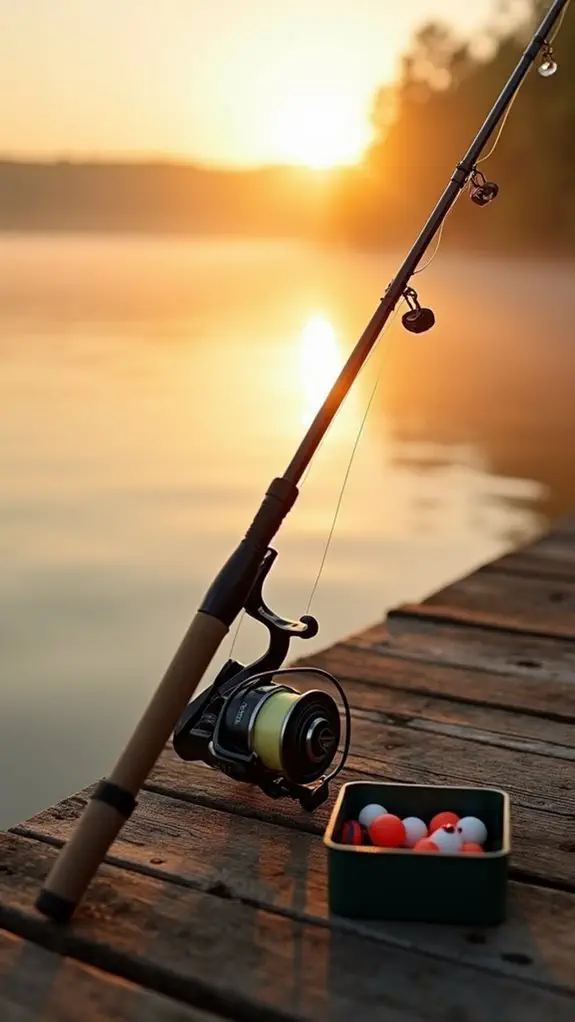
Now that you're set up with a spincast reel, selecting the right fishing rod will complete your basic setup. As a beginner, you'll want to focus on rod materials that offer both durability and forgiveness while you're learning.
The two main rod types you'll encounter are graphite and fiberglass, with graphite being lighter but more fragile, and fiberglass offering greater durability for those "oops" moments we all have when starting out. Spinning reels minimize tangles while you develop your technique. Many local tackle shops offer pre-matched combos that take the guesswork out of pairing your gear.
For your first rod, consider these beginner-friendly features that'll make your fishing experience more enjoyable:
- A medium-length rod (6-7 feet) for balanced casting and control
- Hybrid construction combining graphite and fiberglass for the best of both worlds
- Comfortable grip material to prevent hand fatigue during long fishing sessions
- Medium action for versatility across different fishing situations
- Matching rod power to your intended catch (medium power works well for most situations)
The Ugly Stik GX2 is a perfect example of what you should look for – it's tough enough to handle beginner mistakes while being sensitive enough to feel those exciting first bites.
Best Fish For Beginners
Selecting the right fish species can make or break your early fishing experiences. You'll want to start with fish that are both abundant and willing to bite, making your first catches more likely and enjoyable.
Bluegill and panfish are perfect for learning beginner techniques, as they're found practically everywhere and aren't too picky about what they'll bite. Using crickets and crawlers will help attract these eager feeders. You'll often find them swimming in schools, which means when you catch one, there's a good chance you'll catch more! A medium-action spinning rod is ideal for catching these species effectively.
Rainbow trout are another excellent choice – they're not easily spooked and will give you an exciting fight that'll keep you coming back for more.
As you build confidence, don't be surprised if you hook into a catfish while targeting panfish. These whisker-wearing warriors share the same waters and can be caught using similar methods. They're like the bonus prize of beginner fishing – you might be aiming for a modest panfish, but end up with an impressive catfish story to tell!
The best part about these fish species is that they're all accessible and can be caught with basic equipment, making them ideal for your fishing journey's first chapter.
Essential Bait and Lures
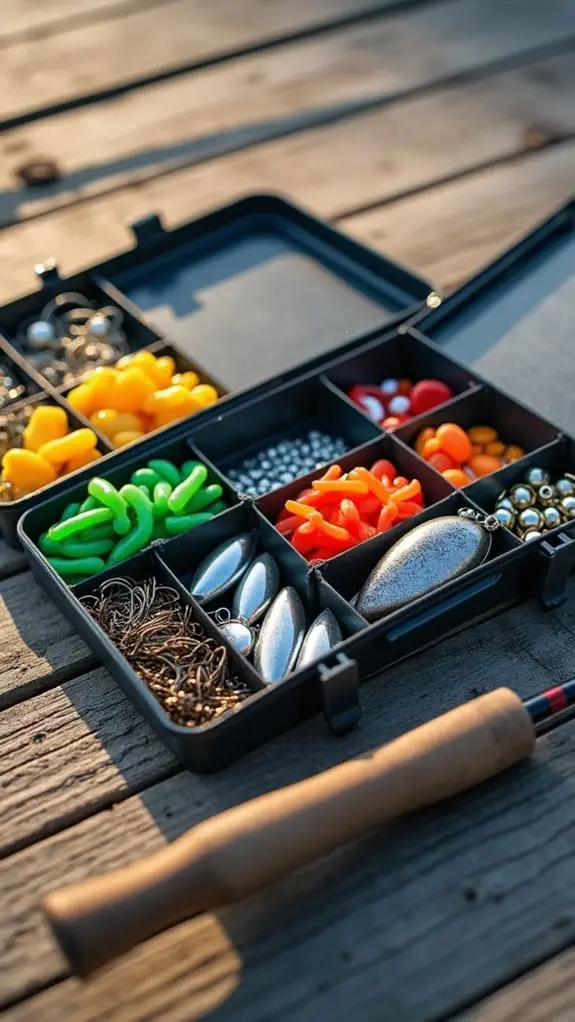
When you're starting out fishing, you'll need to decide between live bait (like worms and minnows) or artificial lures (such as spinnerbaits and jigs).
For beginners, it's smart to start with simple and versatile lures like spinnerbaits or inline spinners that'll work year-round and won't break the bank. The MMD Soft Prawn is particularly beginner-friendly with its realistic design and light weight. Understanding that fish occupy three water zones helps you choose the right lure for where they're feeding.
You'll want to match your bait to the season – think nightcrawlers in spring, plastic worms in summer, and jigs in fall – while keeping a few reliable options in your tackle box.
Live Bait Vs Artificial
The choice between live bait and artificial lures can make or break your early fishing success. While live bait advantages include a stronger feeding response from fish and minimal skill requirements, artificial lure benefits offer convenience and durability that'll save you time in the long run.
You'll find that live bait, like worms and minnows, naturally attracts fish and can help you land bigger catches as a beginner. However, it's important to contemplate the maintenance required and limited lifespan of live bait.
On the flip side, artificial lures might test your patience with their learning curve, but they'll help you develop valuable fishing skills.
Here's what you should contemplate when making your choice:
- Live bait is more effective at triggering instinctive bites
- Artificial lures don't expire and can be reused repeatedly
- Live bait requires regular maintenance and replacement
- Artificial lures offer more control over presentation
- Live bait tends to be more cost-effective for occasional trips
If you're just starting out, you might want to begin with live bait to build your confidence, then gradually shift to artificial lures as your skills improve. This balanced approach will help you become a more versatile angler.
Best Starter Lure Choices
Plunge into the world of fishing lures with these essential starter choices that'll boost your success on the water. Your lure selection can make or break your fishing experience, so let's break it down into three key zones: top, middle, and bottom.
For surface action, you can't go wrong with poppers and buzzbaits – they create that irresistible commotion that makes fish strike.
When you're targeting the middle water column, spinnerbaits and crankbaits are your best friends. They flash and wiggle just like real baitfish, making them perfect for beginners mastering basic fishing techniques.
Bottom fishing doesn't have to be complicated. Start with Texas-rigged plastics or Ned rigs – they're practically foolproof and work great for nabbing those bottom-dwelling fish.
If you're not sure where to start, grab some versatile options like Rooster Tails or soft plastic lures. They're like the Swiss Army knives of fishing – they'll work in almost any situation.
Seasonal Bait Selection
Mastering seasonal bait selection can transform your fishing success throughout the year. Understanding seasonal patterns and knowing which bait variations work best during different times will help you catch more fish with less frustration.
You'll need to adapt your approach as the water temperature and fish behavior change throughout the seasons.
Here are the key seasonal strategies you'll want to follow:
- In winter, slow down your techniques with jigs and soft plastics in darker colors.
- During spring, match the pre-spawn and spawn periods with jerkbaits and lizards.
- For summer tactics, focus on topwater baits early and late in the day.
- In fall, try spinnerbaits and crankbaits around structure and drop-offs.
- Adjust your retrieve speed to match the fish's activity level in each season.
Your best approach is to start with these basic seasonal patterns and build your confidence.
During winter, you'll want to fish slowly and deep, while spring strategies call for matching spawning behavior.
Summer tactics often focus on early morning and late evening activity, and fall approaches require you to follow baitfish movements.
Where To Fish
When you're starting out as a beginner angler, you'll find that shore fishing, shallow waters, and local lakes offer the perfect combination for success.
Your nearby ponds and lakes provide easy access points where you can practice your casting techniques while staying close to home.
These spots aren't just convenient – they're also full of fish that are more likely to bite, especially in areas where the water's depth gradually changes and there's plenty of natural cover like fallen trees or vegetation.
Shore Fishing For Success
The key to successful shore fishing lies in selecting the right location along the water's edge. Look for shoreline structures like docks, fallen trees, and rock piles where fish love to hide.
You'll want to find spots away from heavy fishing pressure, as fish tend to be more active in quieter, less-disturbed areas.
To make the most of your shore fishing adventure, you'll need the right gear and approach. A medium-weight spinning rod and reel combo will serve you well as you learn the basics.
When you're ready to cast, try these proven strategies:
- Cast parallel to the shoreline instead of straight out
- Focus on areas where the shoreline drops into deeper water
- Target spots with natural vegetation or submerged logs
- Look for remote locations away from busy areas
- Change positions every 15-20 minutes if you're not getting bites
Shallow Water Hot Spots
Finding prime shallow water hot spots can dramatically improve your fishing success.
You'll want to focus on areas where different types of bottom surfaces meet, like where sand shifts to rock or where mud meets gravel. These hot spot locations are like nature's buffet tables for fish, offering them plenty of food and shelter options.
Keep an eye out for structural elements that create perfect fishing zones. Weed beds, especially along their edges, are fantastic places to cast your line.
You'll also find success around underwater points and boulders, where fish love to hide and ambush their prey. These fishing tactics work especially well when you're targeting areas with mixed features, like sand bars that have weeds growing on one side.
Don't overlook environmental factors when choosing your spot. If it's a sunny day, look for shaded areas where fish might be seeking cooler water.
In rivers and streams, focus on deeper pools and current breaks – they're like fish highways with convenient rest stops!
Local Lakes And Ponds
Selecting the right local pond or lake can make or break your fishing experience. When you're starting out, smaller bodies of water like ponds offer excellent opportunities to develop your fishing techniques. They're less intimidating than large lakes and often have healthy populations of fish near easily accessible shorelines.
For successful pond fishing, you'll want to focus on these essential elements:
- Look for structures like fallen trees, docks, or submerged logs where fish love to hang out
- Fish during prime hours – early morning or late evening when fish are most active
- Use light tackle, including a medium-action spinning rod with 6-10 pound test line
- Start with live bait like worms or minnows before graduating to artificial lures
- Cast parallel to the shoreline to keep your bait in the "strike zone" longer
Basic Casting Techniques

Learning proper casting techniques forms the foundation of successful fishing. Whether you're using a spincast, spinning, or baitcasting reel, mastering the basics will help you achieve better casting accuracy and spend more time catching fish rather than untangling lines.
For beginners, a spincast reel is your best friend. You'll start by holding the rod at waist level, pressing the button, and bringing the rod back to what we call the "10 o'clock position." As you swing forward, release the button and watch your line sail toward your target. It's like learning to ride a bike – a bit wobbly at first, but you'll get the hang of it!
Once you've mastered spincasting, you might want to try spinning or baitcasting reels. These require more practice but offer greater control and distance.
Remember that proper reel maintenance is just as important as technique. Keep your equipment clean and well-maintained, and you'll be casting like a pro in no time.
Start with short casts in an open area, and gradually increase your distance as your confidence grows.
Safety On The Water
Before you head out on your fishing adventure, you'll need essential safety gear like life jackets, a first aid kit, and emergency flares to keep you protected on the water.
You'll want to check the weather and water conditions ahead of time, as Mother Nature can turn a perfect fishing day into a challenging situation pretty quickly.
Keeping your boat in shipshape condition, following weight limits, and maintaining neat, organized equipment will help guarantee you're not only catching fish but staying safe while doing it.
Essential Safety Equipment Needed
A well-equipped fisher always prioritizes safety on the water, and there's essential gear you'll need before casting your first line.
Whether you're heading out on a boat or fishing from shore, having the right safety equipment isn't just smart – it's often required by law. You'll want to start with a properly fitting life jacket, which is non-negotiable when you're on the water.
Here are your must-have safety items for a worry-free fishing experience:
- Life jacket and whistle (because swimming wasn't part of today's plan!)
- First aid kit with fishing-specific tools like hook removers
- Waterproof bag for your phone and a portable charger
- Emergency flares and floating lights for visibility
- Non-slip footwear and polarized sunglasses
Don't forget to file a float plan with someone you trust before heading out – it's like leaving breadcrumbs for your safety net back home.
You'll also want to bring a buddy along whenever possible, because fishing's more fun (and safer) when you're not flying solo.
Weather And Water Conditions
Understanding weather and water conditions can make the difference between a successful fishing trip and a dangerous situation. As a beginner, you'll want to become familiar with basic weather patterns that affect fish behavior and your safety on the water.
Start by checking the weather forecast before heading out. You'll find that fish are most active during stable conditions, particularly when there's light cloud cover and a gentle breeze. If you notice the barometric pressure falling, that's actually good news – fish tend to feed more actively in shallow waters during these times.
However, if you see storm clouds gathering or strong winds picking up, it's best to postpone your trip.
Water clarity plays an essential role in your fishing success, too. After light rain, fish often become more active as organic materials wash into the water, attracting smaller prey fish. But during heavy rainfall, the water can become too murky for effective fishing.
When you're just starting out, aim for days with moderate weather conditions – not too hot, not too cold, with good visibility and calm waters. This'll give you the best chance to practice your techniques while staying safe.
Boat Safety Best Practices
Safety on the water starts with proper preparation and adherence to basic boating rules. Before you head out fishing, you'll need to confirm your boat has all the required safety equipment and that everyone knows the emergency procedures.
Don't worry – while boat safety might seem overwhelming at first, it's really just about following some straightforward guidelines and using common sense.
Here are the must-follow safety practices for your fishing adventure:
- Always wear your life jacket – it's not just smart, it's required by law
- Check your safety gear before departure, including fire extinguishers and sound devices
- File a float plan with someone on shore – think of it as your "just in case" backup plan
- Keep emergency equipment easily accessible and teach everyone where to find it
- Monitor weather conditions and have a backup plan if things turn stormy
Remember to conduct a thorough pre-departure check of your boat and equipment.
You'll want to inspect your navigation lights, test your horn, and confirm all safety devices are in good working order.
When you're prepared, you can focus on what really matters – enjoying your time on the water and catching some fish!
Required Fishing Permits
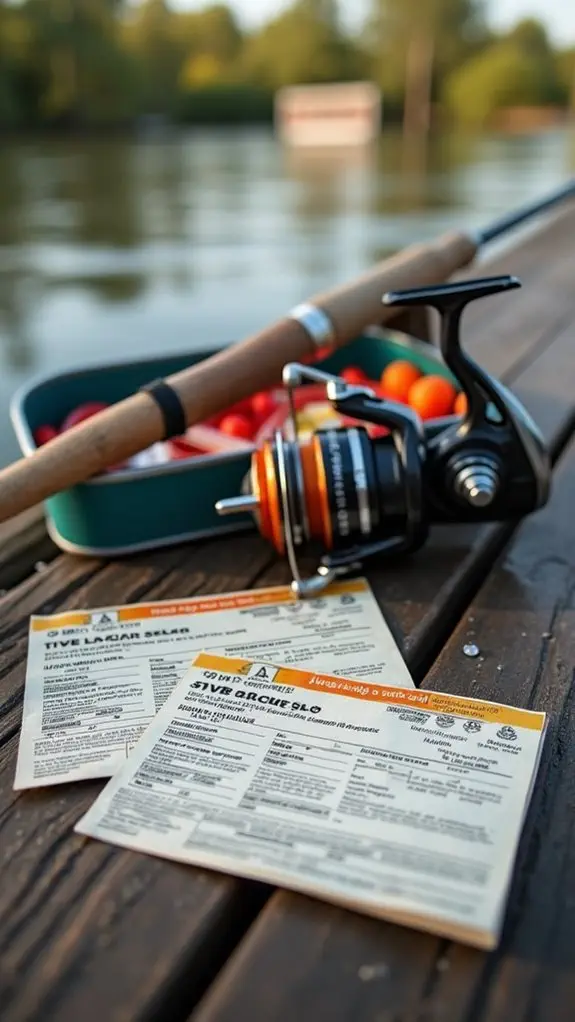
Every angler aged 16 and older must obtain a New York State Fishing License before casting a line in freshwater.
If you're ready to start your fishing journey, you'll find several fishing license types to choose from, including 1-day, 7-day, annual, and lifetime options. The good news is that getting your license is straightforward – you can purchase it online, by phone, or in person.
Before you select your license, you'll need to evaluate the residency requirements. If you've lived in New York for at least 30 days, you qualify for resident rates, which are more budget-friendly than non-resident fees.
You'll also want to check if you're eligible for any special considerations – active service members, veterans, and Native Americans may qualify for free or reduced-fee licenses.
Don't forget about those Free Fishing Days – they're perfect for testing the waters without committing to a license.
And if you're planning to fish in marine waters, you'll need to register with the Recreational Marine Fishing Registry.
It might seem like a lot to remember, but think of it as your ticket to countless adventures on New York's beautiful waterways.
Common Beginner Mistakes
When venturing into the world of fishing, beginners often stumble over common mistakes that can make the difference between a successful catch and a frustrating day on the water.
Understanding proper lure selection tips and retrieval techniques will help you avoid these pitfalls and become a more successful angler. You'll want to match your lures to the environment you're fishing in, and remember that patience is key when retrieving your bait.
Here are some common mistakes you'll want to avoid:
- Using heavy lures in weedy areas where they're likely to get snagged
- Retrieving your bait too quickly, not giving fish enough time to strike
- Not changing worn-out hooks and fishing lines regularly
- Sticking to the same spot or technique when fish aren't biting
- Forgetting to adjust your approach based on weather conditions
Frequently Asked Questions
How Do I Know When a Fish Is Actually Biting My Line?
You'll know it's a bite when you feel sudden line movement, tugs, or continuous tension. Watch for the line swimming off or jumping, and keep your finger on the line to detect vibrations.
What Time of Day Do Fish Bite Most Actively?
You'll find fish are most active during midday (10 AM-2 PM) when water's warmest and visibility's best. While morning hours and evening activity can work, midday typically offers the most consistent bites for catching fish.
Should I Fish Alone or Join a Fishing Club as Beginner?
You'll benefit most from joining a fishing club as a beginner. You'll gain fishing buddies, learn faster through shared knowledge, and enjoy club benefits like structured learning, while still having freedom to fish solo occasionally.
How Do I Properly Clean and Maintain My Fishing Equipment?
After each use, rinse your gear with fresh water, dry thoroughly, and oil moving parts. Store your equipment in a dry place, and don't forget regular maintenance like cleaning reels and inspecting lines for damage.
What Should I Do if My Fishing Line Gets Tangled Underwater?
Don't panic when your line's tangled underwater. Cut the line above the tangle, re-tie your tackle, and focus on proper line management next time. In deep water, try jerking upward with controlled underwater techniques.
Final Thoughts
You're now equipped with the basics to start your fishing journey! Remember to keep it simple with a spincast reel, choose the right rod length, and focus on catching easy fish like bluegill or bass. Don't forget your permit, and always prioritize safety on the water. While you'll make some mistakes along the way, that's all part of the learning process. Now grab your gear, head to the water, and start making memories!


